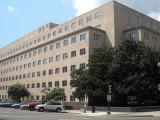(CIDRAP Business Source Osterholm Briefing) – "Expect the unexpected." I'm sticking with this mantra for the H1N1 influenza pandemic. I'd like to suggest you do, too—especially now.
It's hard to believe that less than a year ago, we were talking about pandemic planning fatigue. Now it's as if we're experiencing pandemic presence fatigue.
For some, the first influenza pandemic of the 21st century seems to be largely a "nonevent," particularly compared to what it would be like if we had a severe 1918-like pandemic. Others might tell you the experience has been a disaster, especially if they have lost loved ones, friends, or colleagues to H1N1 virus infection, seen actual workplace disruptions, or been unable to find a dose of vaccine for themselves or a "high-risk" family member. We'd all really like to know if the pandemic, or at least this wave, is on the wane.
Before I address that question, let me give you an analogy. Imagine you had just been through a bad storm. If you lived in the Midwest, watching the clouds move on could mean the storm was passing. But if you lived along the Gulf Coast, the passing clouds might just mean you were sitting in the eye of a hurricane and more bad weather was mere hours away. What if you had no idea which storm you were in?
So, where are we now?
In mid-August I predicted that we'd see the peak of the fall wave of illnesses in North America in mid- to late October. While it appears that H1N1 activity hasn't yet peaked all across the country, it looks to be only a matter of days before it does.
In other parts of the Northern Hemisphere, we're seeing various "stages" of peak activity, with some countries experiencing conditions similar to activity in the US and others several weeks behind.
I would anticipate that by mid- to late December, H1N1 illness activity in North America will reach the same lows it did in late July. The remainder of the world will follow suit, though we'll see some differences in tropical and semitropical countries as well as a lower occurrence of disease during the Southern Hemisphere's summer months.
Not in Kansas anymore
Beyond that, we face a huge unknown. We're about to enter the realm of "expect the unexpected." Will we see a winter/early spring third wave of H1N1 infection in the Northern Hemisphere? Maybe. If we do, we could see anything from limited novel H1N1 activity like a mild, regular influenza winter season to a full-blown third wave that exceeds our experience of the last 3 months. We just don't know.
Now, if we add in the possibility of any significant mutational or reassortment change in the virus in the next few months, all bets are off about future disease. Remember, if even 35% to 40% of the population has already been infected or has antibodies from exposure decades ago, the remaining 60% to 65% of the population still might be susceptible to this virus.
So where does this leave us with H1N1 vaccine?
I surely don't need to tell you about the frustrating disconnect between the amount of vaccine promised throughout the summer and the much lower number of doses available as of today. Of note, all countries that ordered H1N1 vaccine are experiencing serious delays in receiving their orders; it's not just the US.
We remain at the mercy of a 1950s vaccine technology, a topic I've addressed before in this column. No one person or organization is at fault for the poor vaccine virus production in chicken eggs. When Mother Nature, specifically the influenza virus, is in charge, we should anticipate production glitches.
While only 40 million doses of H1N1 vaccine have been delivered to date, this number will surely increase dramatically by the beginning of 2010. Given the potential for a serious winter wave of H1N1 infection, we need to convince our loved ones, friends, employees, and colleagues to get vaccinated. Of particular concern are people at high risk of developing severe complications. I know this could be a tough sell if there's little disease occurring, but vaccination will be a critical to ensuring illness is minimized and that a potential winter wave does not cause a serious disruption in our organizations. I'll address this topic in future columns.
Also remember that most of the world will never have access to H1N1 vaccine. So if the virus does change or a serious winter wave develops, we may yet experience potential supply-chain disruptions or limits on travel in other countries around the world.
So what should we do now?
As fatigued as you and your organization may be, please don't let down your guard yet. Instead, I suggest you do the following:
- Keep the storm analogy in mind. Know that the possibility that we are in the eye of a hurricane is just as real as the possibility that the storm is passing. It's too early to take chances that might jeopardize the health of your employees or business. Keep your eyes on what's brewing around early winter.
- Learn from what you've experienced to date in your organization. The education we're getting now is invaluable. Look for the lessons from your organization's response to date, and apply them now. Remember, too, that we haven't seen the last of the H5N1 virus.
- Download and read Doing Business During an Influenza Pandemic: Human Resource Policies, Protocols, Templates, Tools, & Tips. Organizations have long asked for "best practices" in pandemic planning and response. It's too early to know just what a best practice is, but this toolkit is the closest you're going to get to finding the next-best thing: what real companies have been doing and what's worked. With contractual support from the Centers for Disease Control and Prevention (CDC), we partnered with the Society for Human Resource Management (SHRM) to produce this wealth of information. Take advantage of it.
- Remember the possible impact of seasonal influenza. We don't know what will happen with H1N1. We do know it has largely displaced seasonal influenza strains. But the flu season is not over. It still makes sense to get a seasonal flu shot as the seasonal strains surely could return so encourage your employees to get one.
- Expect the unexpected. While no one could have been so prescient in April as to have precisely described each and every aspect of what has unfolded, everything that has happened clearly should have been a possibility on planning tables. Even the current vaccine shortage experienced around the world—not just in the US—could have and should have been anticipated. Having said all this, there's surely another unexpected turn around the corner.
Bottom line for organizations
You can expect to see signs that the pandemic is waning in the coming days and weeks. But keep your pandemic "weather station" turned on. We may be in the eye of the hurricane.


















